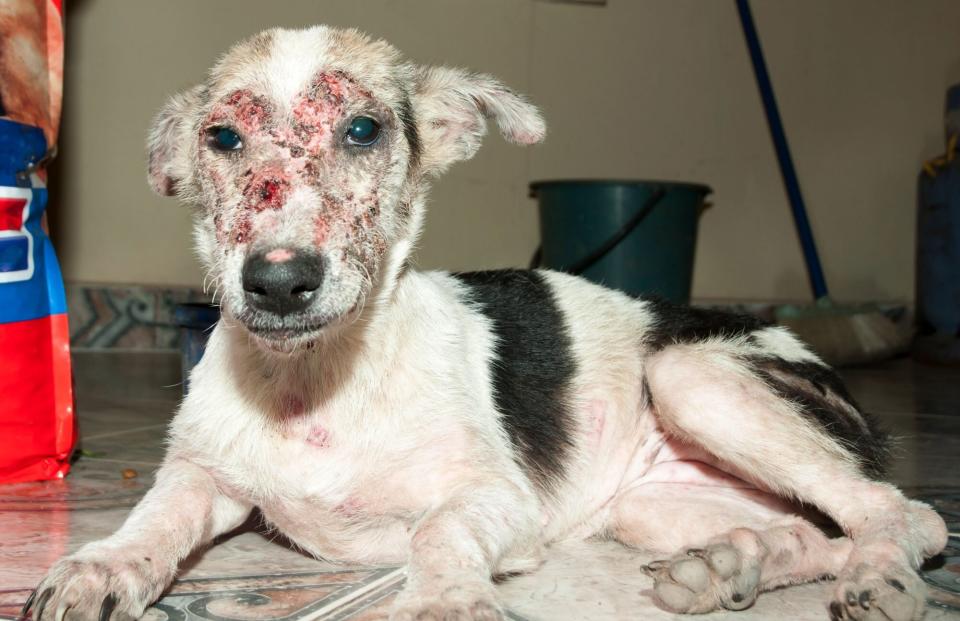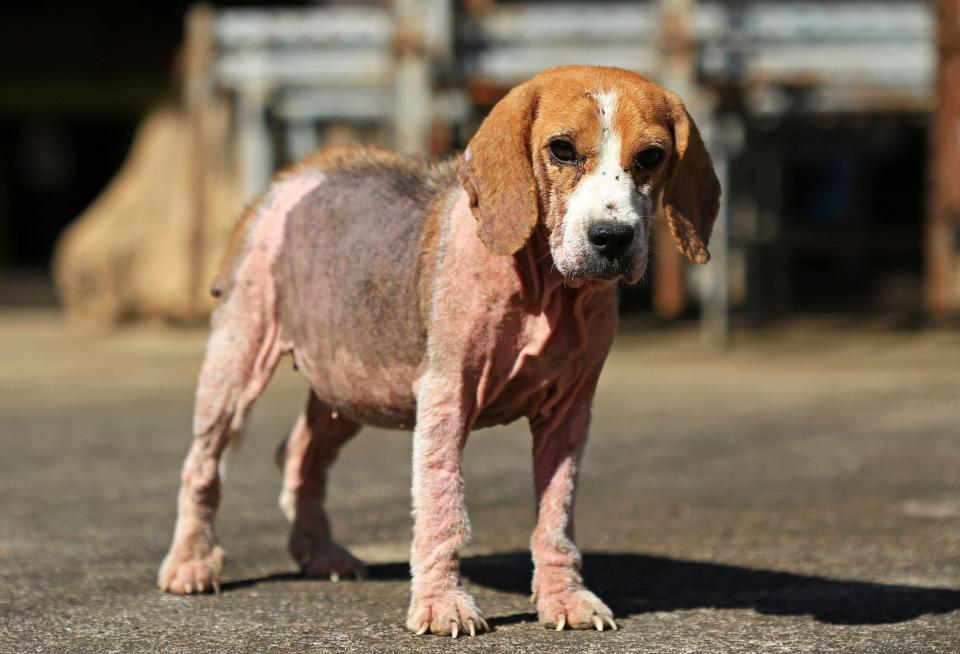How to Recognize, Treat, and Prevent Mange in Dogs
If your dog is itching like crazy or you notice patches of thinning or missing fur, your pup may have mange. This irritating skin condition is caused by microscopic mites that infest the skin. But there's no need to stress: Mange in dogs is preventable and treatable.

Getty
What Type of Mite: Sarcoptic or Demodectic?
There are two types of mange, and the kind your dog has will depend on which type of mite is causing the problem. Mange is most commonly caused by the sarcoptic mite, Sarcoptes scabiei, or a closely related mite species like Notoedres. This type of mange is called scabies. Your dog can catch these parasites from another animal or from contaminated bedding and give them to you.
Demodectic mites, on the other hand, are naturally present in the roots of your dog's fur (called hair follicles). They're passed from mother to pup during the first few days of life. Normally, a dog's immune system keeps demodectic mites in check. But mange outbreaks can occur if the mite population grows out of control. Mange caused by demodectic mites isn't contagious.

Getty This dog is suffering from sarcoptic mange, a highly contagious form of mange.
Causes and Symptoms of Sarcoptic Mange
Sarcoptic mites can't be seen with the eye, but you'll definitely notice the itchy agony they trigger in your dog. These tiny mites live and feed on your dog's skin, with the females burrowing underneath the top layer to lay eggs.
Mange in dogs caused by sarcoptic mites is highly contagious. "It's commonly spread by wildlife," says Travis Taylor, DVM, medical director of VCA Centreville Animal Hospital in Centreville, Va. "If you have wildlife, especially foxes, coming through your yard, your dog's mange is probably caused by this type of mite."
Besides wild animals, your dog can also get sarcoptic mites from other dogs. Mites can pass between dogs that live or play together or at places like a boarding facility or a shelter. Dogs can also pick up a case of mange from infected bedding or blankets, but it's possible that symptoms may not show until 10 days to eight weeks after exposure.
"Early-stage sarcoptic mange usually starts out as an itch around the ear flaps and the elbows," Taylor says. But mites also like living on a dog's belly, armpits, and legs.
Initially, a dog with sarcoptic mange scratches constantly, making the skin under the fur red and irritated. Over time though, sarcoptic mange leads to hair loss, open sores or scabs, and crusting or thickening of the skin. The open sores may get infected and become smelly. If left untreated, it can lead to enlarged lymph nodes, loss of healthy muscle, and sometimes death.
While sarcoptic mites prefer dogs, they can also infect people. They cause an incredibly itchy but short-lived rash in humans.

Getty This beagle has demodicosis, also called demodectic mange or red mange.
Causes and Symptoms of Demodectic Mange
Demodectic mites (demodex) are present in a dog's hair follicles and the skin's oil glands from puppyhood. For most dogs, they don't cause a problem. If they do become troublesome, it's typically a sign of a weakened immune system. Puppies, older dogs, and those with underlying medical conditions such as diabetes or cancer are more likely to get demodectic mange. cause localized or generalized
Demodectic mange may be localized or generalized. When there's an overgrowth of demodectic mites, hair follicles become irritated. "Demodex mange is more subtle than sarcoptic mange in the early stages," Taylor says. "It's not as itchy. It usually starts out as small areas of hair loss." This is known as localized demodex.
Puppies with demodectic mange—also called red mange—develop scaly bald spots near the lips and on the head or front legs. Oftentimes, the immune systems of puppies will kick in and resolve the problem on its own.
Other times, demodectic mange becomes widespread. This is considered generalized demodex. As it progresses, you'll see:
More hairless patches
Oily, bumpy skin
Skin discoloration
Itchiness
Scabbing and/or crusting of skin
Bacterial infections with smelly odor
How to Treat Mange in Dogs
While you may be tempted to use a home remedy or over-the-counter product to relieve your dog's itching, it won't help in the long run. Getting rid of the mites is a must in order to treat mange. Schedule an exam with your local vet for an official diagnosis to find out what kind of mange your dog has, and how to best treat it.
Mange symptoms are similar to other skin conditions in dogs. Your veterinarian will take a skin scraping or hair sample and look at it under a microscope. The skin scrape may temporarily cause the skin to look more irritated, but it's important to do! It's easy to see demodectic mites under the microscope. Sarcoptic mites, on the other hand, can be difficult to spot since they burrow under the skin. Your veterinarian may recommend additional tests to rule out other conditions.
The good news, Taylor says, is that mange treatment has become much easier than for earlier generations. "In the past, we had to rely on dips or daily treatments. Now, we use isoxazoline medications—a group of drugs that many once-monthly flea and tick control products contain. We've found that they're very good at treating both types of mites, in addition to their main use for fleas and ticks."
Taylor says you can expect your pet to feel better within a few days of taking the oral medication. To help take care of the itch while the mites are being killed off, vets often prescribe medications to relieve itching, discomfort, and inflammation. Treatment may include a steroid drug like prednisone. Your dog may also need antibiotics to help clear up any secondary skin infections.

Getty This young puppy has demodectic mange, causing the patchy appearance of his fur.
Is it Possible to Prevent Mange in Dogs?
The use of isoxazoline medications has another bonus—not only does this class of medicine treat dogs for mange, but it can also help to prevent it. "The likelihood that dogs on these preventative medications will develop anything more than a minor mite infection is pretty minimal," Taylor says.
RELATED: How to Treat & Prevent Ear Mites in Dogs
Is Mange Contagious to Humans or Other Pets?
Unfortunately, mange due to sarcoptic mites can spread to other pets in the home and even humans. Special precautions are necessary to keep it from infecting other inhabitants in the home since mites are easily transmittable to other dogs and people.
It's important to isolate your dog from other pets until your dog is free of mites and be sure to keep your dog off furniture and clean all material your dog has been in contact with including their bed, your mattress, blankets, and the carpet. Your veterinarian can give you detailed instructions on how to eliminate sarcoptic mites at home and keep them from coming back.

